Air Vitamin (Negative Ions from Salt)
Modern science, particularly branches that study the vital energy of all objects and phenomena in the universe, has shown that salt possesses a high level of life energy, similar to that of the sun, which can provide humans with significant energy. This aligns closely with ancient Eastern practices, such as Eastern wisdom, temperament theory, and yoga.
The concept of life force, a key idea in Eastern medicine and yoga, refers to the energy drawn from the sun, which connects cosmic elements. In the temperament theory of Avicenna (Ibn Sina) in Iran, everything in the universe, including objects, human emotions, and natural phenomena, has its own specific temperament. According to this theory, the more harmonious the temperaments of objects, the greater the harmony in their physical energies.
In the tradition of temperament science, the sun, salt, joy, tranquility, love, happiness, and hope are all considered warm and dry, referred to as “Saffravi” or bilious in this framework. When a person is in an environment rich in salt, the harmonious temperamental balance increases their mental and spiritual energy.
While modern life has been made easier with technologies like microwaves, TVs, mobile phones, and computers, these devices disturb the ion balance around us, potentially leading to harmful effects.
Diseases caused by the imbalance of inorganic salts in the body, primarily due to an overload of positive ions from these electronic devices, have become a growing concern. Salt crystals, with their ability to release negative ions, help to restore the body’s natural frequency and bring it back into balance.
The release of negative ions is a unique characteristic of salt crystals. Scientifically, negative ions help balance the electromagnetic field of the brain. In quantum physics, these negative ions are referred to as “air vitamins.”
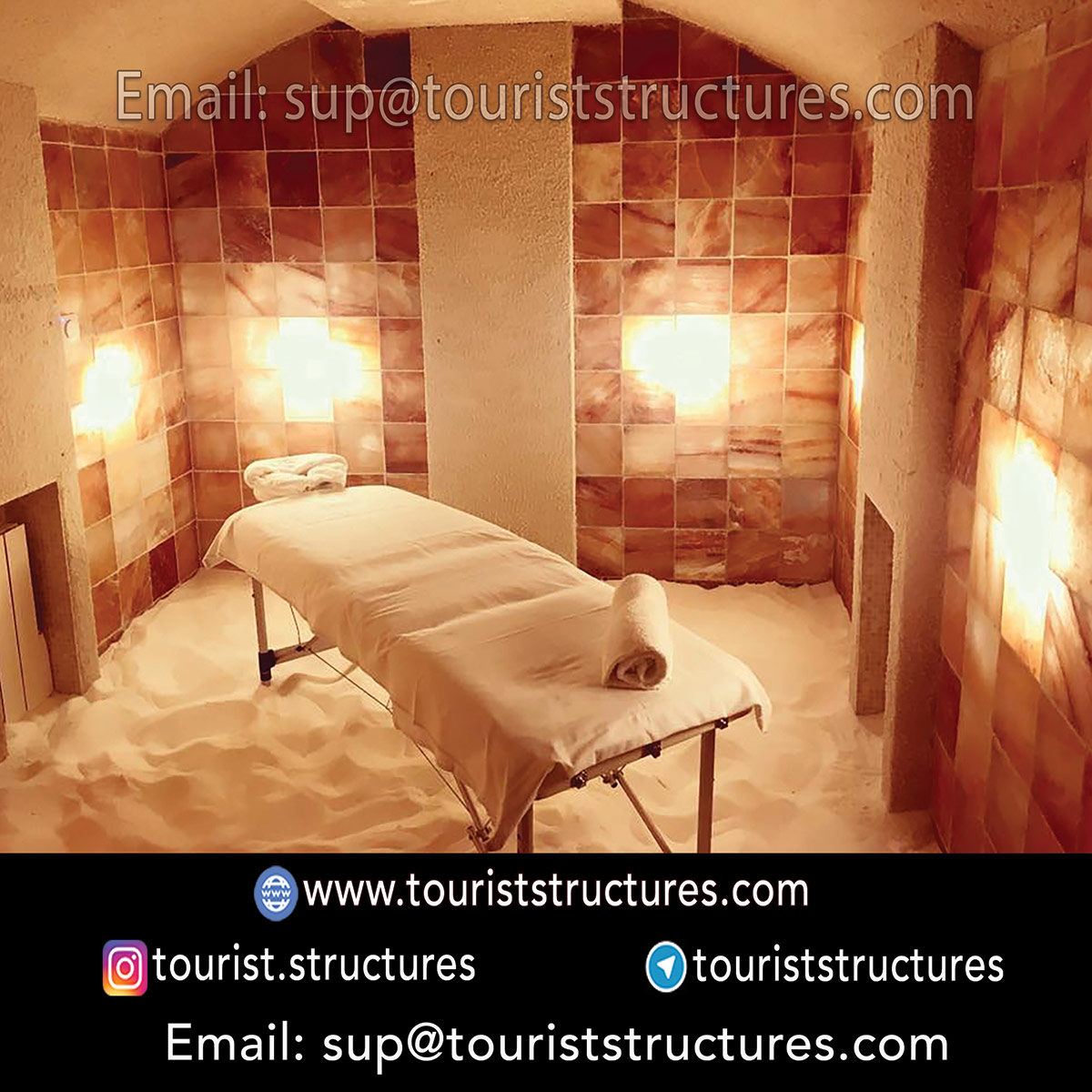

Salt spaces: Centers for positive energy
What is Salt Therapy?
Pure medical-grade salt is highly effective at killing bacteria and germs. One of the latest completely natural therapies gaining popularity, especially for respiratory and skin conditions, is salt therapy in salt caves. This method is recommended not only for patients but also for anyone looking to benefit from its calming and healing properties.


Salt therapy in salt caves, a soothing and therapeutic experience
There are two types of salt therapy:
Speleotherapy: This method exposes the patient to natural salts found in mines or underground caves, where the conditions are ideal for healing. Salt caves, common in Europe, are composed of salt deposits that have settled over thousands of years. These caves are often used to treat people with respiratory conditions.


Salt therapy using the speleotherapy method.
Halotherapy: This form of salt therapy can help alleviate a variety of health conditions. If you suffer from asthma, allergies, respiratory problems, or even COPD, you may be an ideal candidate for salt therapy.
This treatment is conducted in a controlled salt environment rather than in natural settings like mines or caves. The treatment can take place in salt rooms, salt chambers, or by dispersing powdered salt into the air. With just the push of a button, salt crystals are released into the air as fine salt powder or through salt pipes, which are then inhaled. Salt lamps are also used to amplify the effects of natural salt. In some cases, patients drink saline solutions as a remedy for respiratory problems.


Salt therapy using the halotherapy method.
Breathing salt-infused air can be done through two treatment methods: dry and wet:
Dry method:
In the dry method, a salt generator (halo generator) is used in a moisture-free cave or chamber. The temperature is kept at around 20°C, ideally on the cooler side. The generator disperses fine salt particles into the air, creating a therapeutic environment.
Negative ions from the salt work to absorb harmful toxins from the respiratory system by reducing airway inflammation. Moreover, spending 30-45 minutes in this environment boosts the body’s production of happiness hormones, contributing to reduced stress levels.
Wet method:
As the name suggests, the wet method involves the use of water. In this approach, salt and its saline properties are dispersed into the air using sprays. Common applications include gargling with salt water, drinking saline solutions, taking salt water showers, using salt water for nasal relief, and relaxing in salt water flotation tanks.
Just Breathe!
Salt therapy is a laboratory-based method that harnesses the therapeutic effects of salt to treat various conditions, without the use of drugs or chemicals. Patients don’t need to do anything special—simply sit, relax, and breathe.
This therapy is completely safe for children and infants, and it is said that they respond to it even more quickly than adults.

Salt therapy for children and even infants, conducted in a suitable environment.
Benefits of Salt Therapy:
Salt is often referred to as “the white poison.” While it’s true that excessive consumption can be harmful, this warning pertains to eating salt, not inhaling it! Breathing in salt-infused air is believed to open the lungs. It is considered a bronchodilator, an anti-anxiety agent, and a powerful ally against depression.
The decoration and various types of salt structures become significantly valuable when we recognize the extraordinary and unique properties of salt crystals:
Both sea salt and rock salt are effective in treating various pains, including those associated with inflammation and bruising. They promote relaxation, reduce anxiety and anger, eliminate inflammation in the respiratory tract and sinusitis, alleviate respiratory symptoms, improve coughs caused by smoking and tobacco use, treat common colds and influenza, promote restful sleep, reduce snoring, enhance skin health, remove airborne pollutants from the respiratory system, diminish allergic reactions to air pollution, relieve chronic stress and unexplained fatigue, aid in reducing inflammation, and prove beneficial in treating infections such as ear infections, eczema, acne, dermatitis, and psoriasis.
Moreover, the release of negative ions helps regulate heart rate, support the adrenal and thyroid glands, strengthen the immune and nervous systems, influence cellular activity, detoxify the body, improve digestion, balance energy levels and blood sugar, enhance mood, and provide essential minerals required by the body.


Countless health benefits of salt spaces for human well-being.
Have you heard about the positive energy of salt crystals?
Despite its name, salt exhibits remarkably different physical and chemical properties compared to other stones; one of its unique characteristics is the ability to release negative ions from its surface. Just as hydrogen bonds give water its distinctive properties among liquids, the emission of negative ions by salt distinguishes it from other stones.
Recent scientific studies have identified luminous salt crystals as a natural source of “charged particles.” When sunlight strikes these crystals, they generate specific energy.
Even sunlight hitting translucent salt crystals produces this natural energy. Although the ionization process is invisible, it occurs millions of times without altering the quality of the salt crystal, akin to photosynthesis and oxygen production in plants.
Salt crystals are one of the few minerals that have a crystalline and ionic structure, which allows them to change between solid and dissolved states in water.
Modern quantum science, new biology, and bio-resonance have established that this natural ionization and the abundance of negative ions in the environment generate an electric charge, stabilizing the electromagnetic field of the human brain’s dipoles. This phenomenon fosters a sense of calm, relaxation, and noticeable vitality in individuals exposed to negative ion emissions. A similar experience occurs in nature, where individuals feel tranquility near oceans, waterfalls, or deserts due to the abundance of negative ions (referred to as “air vitamins” in scientific literature) in those environments.
Interestingly, negative ions possess another fascinating property: when they attach to airborne pollutants, they recharge these particles, causing them to settle on the ground or the nearest surface. Consequently, the air within salt rooms remains entirely sterile and clean.


Harnessing positive energy in salt therapy rooms
Why is the release of negative ions so vital?
The significance of an abundance of negative ions in the environment becomes clear when we realize that the human brain typically generates waves at a frequency of 8 Hz. However, in today’s technological era, electrical and electromagnetic devices—such as televisions, computers, mobile phones, satellites, and the internet—produce waves ranging from 100 to 160 Hz.
As a result, the brain is exposed to frequencies approximately 12 to 20 times higher than usual, leading to nervousness, insomnia, sleep deprivation, decreased concentration, fatigue, reduced energy levels, tension, anxiety, irritability, weakened immune function, and hypertension stemming from stress. Additionally, the accumulation of positive ions in the environment creates a cascade of free radicals that may potentially lead to cancer.
Furthermore, homes and offices are often designed in ways that limit the entry of fresh air and negative ions.
Small windows and high levels of air pollution, along with electromagnetic wave traffic in urban areas, fill outside air with positive ions. Besides their role in stabilizing the electromagnetic field of the brain’s dipoles, negative ions can statically attach to airborne particles such as dust, mold spores, microbial particles, and other allergens, causing these pollutants to settle rather than remain airborne.
For this reason, the floors of salt rooms must be cleaned regularly to maintain their effectiveness. This process ensures that the salt is able to continue absorbing airborne pollutants, keeping the room’s air fresh and clean.
The simplest and most economical way to counteract the negative effects of the environment is to introduce fresh air into homes and other enclosed spaces. However, this method is often impractical due to severe air pollution, particularly in large cities.
This challenge has prompted many researchers to explore alternative strategies to reduce air pollution and enhance air quality, ultimately recommending the use of salt crystals to create aesthetically pleasing spaces while purifying indoor air.
Some key properties of colored salt crystals include:
Orange Crystals: Enhance feelings of safety and are highly beneficial for the nervous system. They promote calm moods, regulate temperament, and facilitate urination.
Yellow Crystals: Activate the pancreas and enhance cognitive perception.
Red Crystals: Accelerate blood circulation and boost physical vitality.
Pink Crystals: Enhance feelings of cooperation and love, promoting emotional expression.
White Crystals: Exhibit purifying properties and remove carbon dioxide from living and working spaces.
Brown Crystals: Aid in creating or enhancing a sense of balance in individuals’ minds and bodies.
The History of Salt Therapy:
Salt has played a pivotal role in human civilization for centuries, not only as a staple of daily life but also as a natural healing remedy.
Historical accounts indicate that the ancient Greeks were among the first to notice that those working in salt mines were less prone to respiratory issues and psychological disorders—ailments that were quite common at the time—compared to the general population. This observation led them to become the pioneers in “respiratory salt therapy.” However, due to prevalent superstitions, many of their findings were disregarded or overshadowed by mystical beliefs that coexisted with their empirical observations.
The healing properties of salt caves, dating back to 1100-1500 BCE, were well known, as evidenced by the use of these caves for therapeutic purposes.
Religious monks would often lead ailing individuals into the caves, encouraging them to breathe the air infused with fine salt particles—created by scraping salt stalactites—believing this would aid in their recovery.
In 460 BCE, Hippocrates advocated for the consistent use of salt in his medical practices and particularly recommended inhaling salt-infused steam to alleviate respiratory symptoms. These health benefits were later documented in 1843 by Dr. Felix Bojewski, a Polish physician, solidifying salt therapy’s place in medical history.
The discovery of the “Salt Men” and the several-thousand-year-old mummified bodies in salt mines reveals that people from diverse regions, with unique customs and attire, would journey several miles to reach what was known as “white gold” at the time—salt.
As science progressed and massive salt extraction and production factories emerged, salt transitioned from a precious commodity to a cheap food seasoning, so much so that every dining table had at least 100 to 200 grams of salt available at all times. The excessive consumption of what was once known as “white gold” eventually turned salt into the “white poison” by the time of World War II.
In more recent history, the German Nazi army was the first to harness the therapeutic properties of salt caves. Before military operations, soldiers were kept in salt caves for several days to optimize their mental and respiratory health. However, the precise origins of this practice and the research behind it remain unclear, as the findings were kept confidential.
Salt caves were the first natural spaces that improved people’s respiratory health, paving the way for significant medical advancements. The natural sodium chloride that permeates the air in these caves reduces airway inflammation, much like the salt caves discovered in Poland, Russia, Romania, Austria, and Ukraine. These are just a few examples of countries with such natural formations. This is why Europe became a leader in halotherapy as a medical treatment, with Russia at the forefront, particularly in the late 1980s, pioneering the use of salt in clinical settings to treat respiratory conditions.
Until 1987, the only method for salt therapy was through natural underground salt caves. However, a breakthrough in Russia led to the development of man-made salt chambers that mimicked the therapeutic environment of these caves. These chambers were first built in clinical settings, designed to simulate the conditions of salt mines.
In 1990, Russia’s Ministry of Public Health officially recognized halotherapy as a valid medical treatment, which further enhanced the credibility of ventilated dry salt rooms.
By 2009, European countries began establishing salt therapy rooms and conducting extensive research. However, much of the data and findings remained unpublished, with countries like the U.S. and Canada keeping their research private. Despite this, the increasing prevalence of salt rooms in these nations demonstrated that “salt therapy” was far from being a mere superstition.
Salt therapy rooms are engineered to replicate the conditions of natural salt caves, and as more individuals experience the benefits, these treatments continue to gain popularity worldwide.
In our country, no significant research had been conducted on salt therapy until recently when the people of Zanjan initiated studies. They have taken the lead in exploring the health benefits of salt therapy.
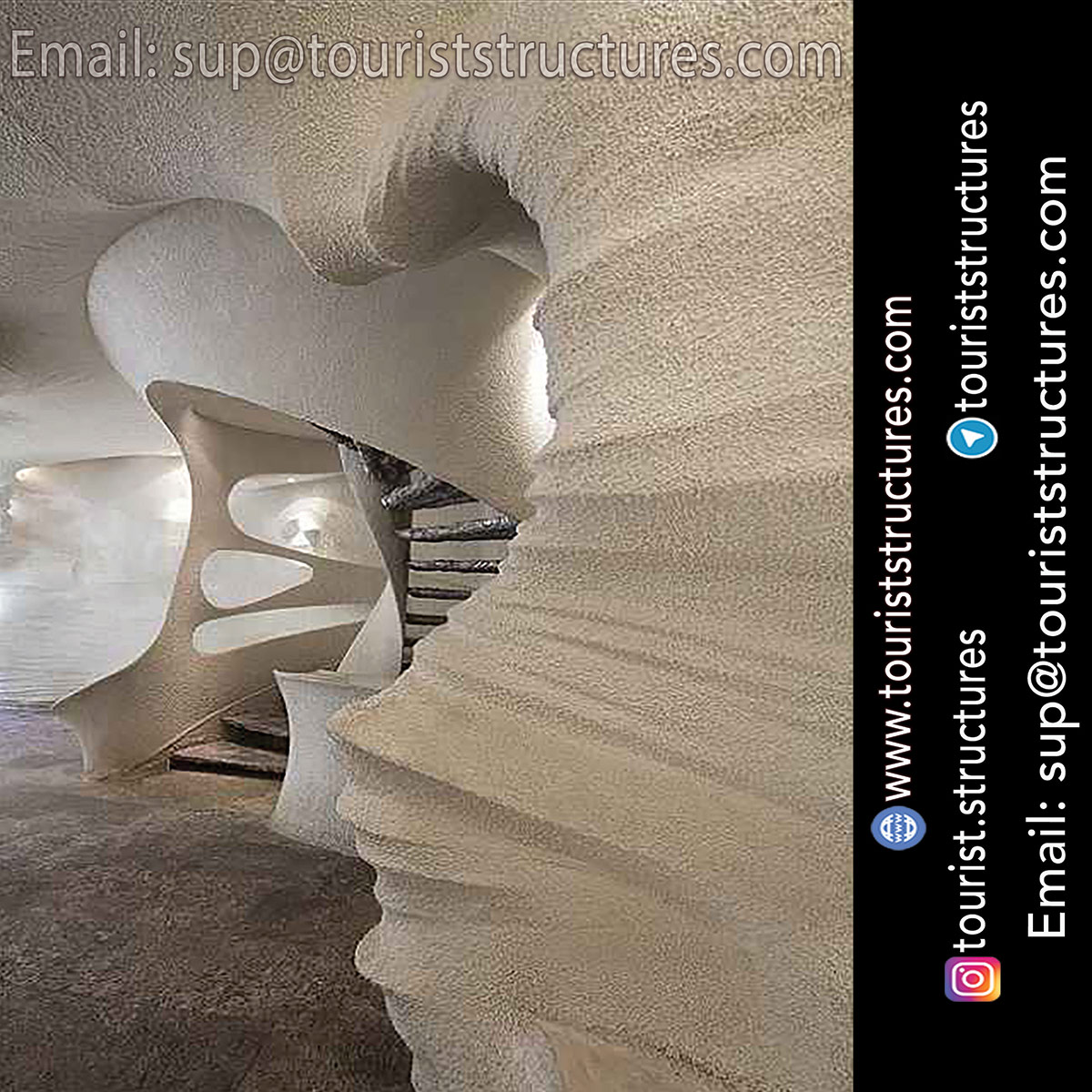

Examples of salt spaces designed as rooms or caves.
What is Rock Salt?
Rock salt, also known as halite, is the mineral form of sodium chloride (NaCl). Genuine rock salt is characterized by its salty flavor, shiny surface, and dry odor. While rock salt is commonly colorless or white, it often contains impurities that result in a range of natural colors. These variations depend on the type and concentration of impurities within the salt, leading to several color categories:
Snow-white rock salt: Contains lime, and lead.
Yellow and orange rock salt: Contains sulfur.
Deep red rock salt: Contains magnesium.
Black rock salt: Contains calcium.
Red rock salt: Contains iron.
The intensity of these colors is directly related to the density of impurities. When constructing a wall from natural rock salt, the raw beauty of nature reveals itself through its spectrum of colors, creating a visually captivating effect as the light filters through unevenly—resulting in a stunning and naturally unique aesthetic.
Uses of Rock Salt:
Rock salt serves three primary purposes: culinary, decorative, and industrial. Additionally, decorative rock salt is often utilized for its therapeutic properties. Here are the three main applications:
1. Edible Salt:
Rock salt is the unprocessed form of the salt we consume. Once it is refined and ground, it is prepared for use in food products. In some cases, iodine may be added during processing. Salt extracted from the sea naturally contains trace amounts of iodine.
2. Industrial Salt:
Apart from its use as food, rock salt is crucial to numerous industrial processes. Many industries rely heavily on this valuable mineral. Industrial salt is essential in activities such as leather tanning, acid production, manufacturing hygiene and cleaning products, livestock and poultry feed, glass production, polyester, plastic, and resin products, among others.
3. Therapeutic Benefits of Rock Salt:
Rock salt is known for its remarkable healing properties, particularly due to the release of negative ions. These negatively charged particles significantly boost blood circulation to the brain, improving mental clarity and reducing fatigue and drowsiness. Moreover, the negative ions in rock salt absorb airborne microbes and pollutants, helping to alleviate allergy symptoms. These unique healing qualities have led to the widespread use of rock salt in both its decorative forms and its raw, unrefined state in homes and workplaces.


Salt therapy rooms, prime examples of using rock salt’s therapeutic benefits.
4. Rock Salt in Interior Design:
The natural impurities and formation conditions of rock salt give it its diverse colors and aesthetic appeal, making it a popular choice for home and office decoration. Various decorative products, such as salt lamps, salt walls, and sculptures, are created from it. People purchase these items not only to enhance the ambiance of their spaces but also to benefit from rock salt’s therapeutic properties.
Additionally, the crystalline structure of rock salt allows light to pass through, offering a unique feature for decorative lighting. You can select the lighting color behind these salt walls to match your interior design. If you decide to refresh the look of your space later, you can easily adjust the lighting with the flip of a switch.
The interplay of dynamic lighting behind these salt structures brings them to life, as if imbuing them with energy, creating an enchanting and soothing visual effect for any observer.




Utilizing rock salt in interior design
Introduction to Common Forms of Salt Rock Usage:
Designing and constructing a salt room is relatively straightforward, allowing you to make use of minimal space. However, it’s essential to note that salt is the primary material required for this room. Additionally, careful consideration should be given to the purchase of other necessary equipment.
1. Salt Rock Blocks:
These are the most significant element in salt-based structures. When selecting salt rocks, it’s essential to choose types that won’t emit harmful gases when heated.
2. Salt Clods:
Salt clods are an attractive option for designing salt structures, adding natural beauty and functionality. Salt clods, sometimes used as night lamps, also offer therapeutic benefits when placed in common rooms.
3. Salt Bricks:
Salt bricks are necessary for more structured designs where irregularly shaped salt rocks cannot be used. Salt bricks are often used in building walls and salt rooms.
Not all salt rocks are suitable for conversion into salt bricks. Standard salt bricks are crafted from high-density salt rocks that can be easily cut. If the rock lacks sufficient density, it may crumble into powder during cutting or develop internal cracks afterward. A proper salt brick is perfectly square, uniform, and meets standard dimensions.
The thickness of salt bricks varies based on their intended use. When used in interior design where light needs to pass through, thinner bricks are preferred. The standard size for a salt brick is 5x20x10 cm, but for improved light transmission, bricks can also be made in 3x20x10 cm. Other available sizes include 10×10, 20×20, and 30×20 cm.
Salt bricks are available in a range of colors, which makes them a unique and appealing addition to interior décor. Popular shades include white, orange with streaks, white with streaks, red, and brown.
The price of salt bricks is influenced by several factors, with quality being one of the most important. The higher the density of the salt rock used to create the brick, the better its quality will be. A premium salt brick should be perfectly square and have six smooth, even surfaces. Additionally, the color and cut of the brick are significant factors in determining its price.
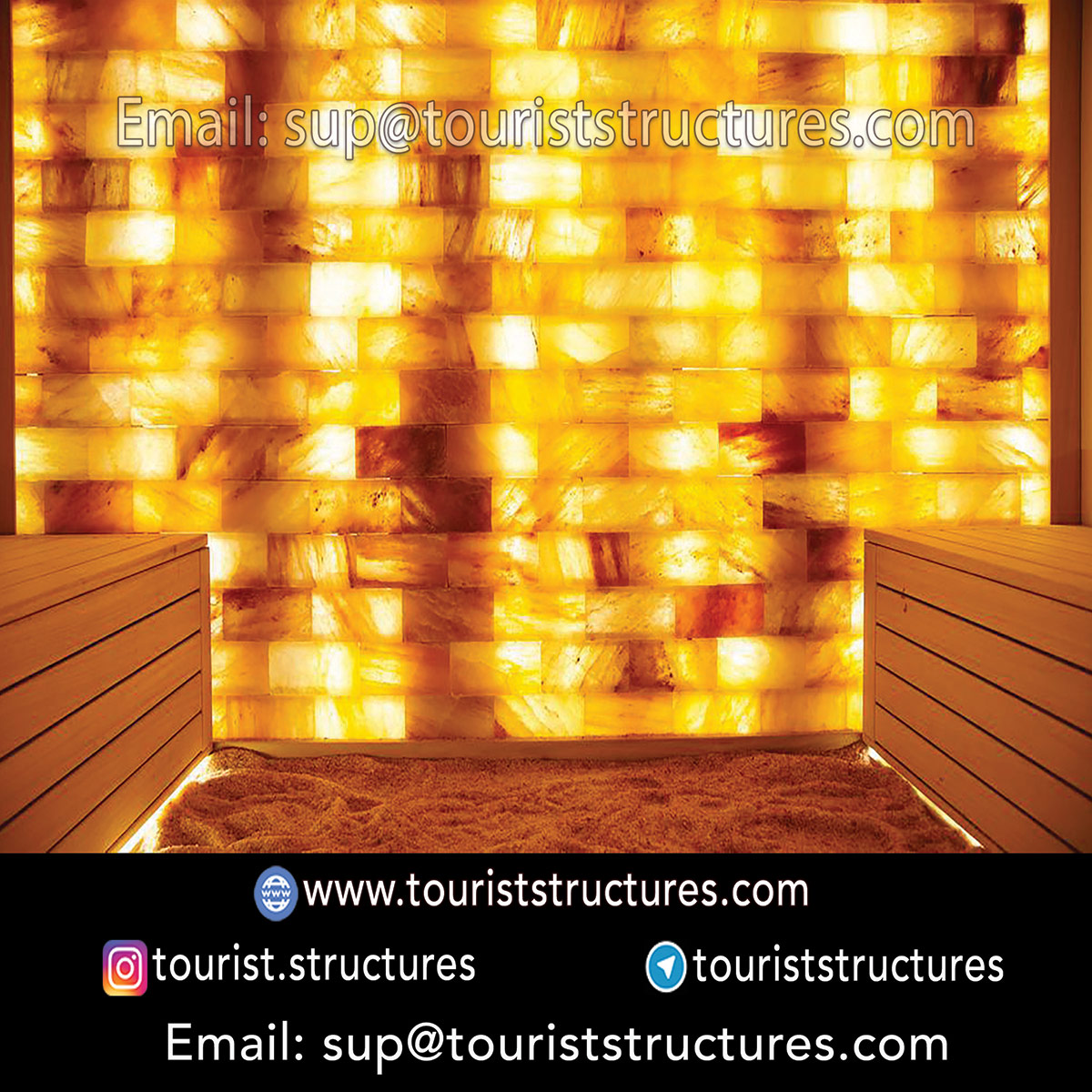

Incorporating and illuminating salt bricks, one of the most stunning and styles in interior decoration.
4. Salt Powder:
In some cases, salt powder is required, such as for creating salt caves where salt is sprinkled onto walls and ceilings to form intricate shapes. Salt powder may also be used for therapeutic purposes, such as massage treatments on the cave floors.
In conclusion, creating a salt room in the form of a salt cave is generally more cost-effective than constructing one with salt bricks. That said, each type of room offers unique benefits, and having both options available is important.
5. Compressed Salt Layers:
In certain salt structures, compressed salt layers are used, as seen in salt-themed restaurants like the one in Shiraz.
What is a Salt Room?
One of the most fascinating aspects of humanity’s journey toward modern scientific progress is the remarkable alignment between recent discoveries and the foundational principles of ancient sciences, as well as the accurate, experience-based knowledge of earlier civilizations, even without the technological advancements we have today. Both ancient traditions and modern science consistently demonstrate that every entity and object in the universe influences and impacts one another.
Since ancient times, humans have shared an inseparable connection with salt. Considering the deep-rooted bond between humans and nature—and the positive impact it has on both physical and mental well-being—natural structures can play a significant role in fostering peace and tranquility. Salt caves and salt mountains, some of the earliest formations on Earth, have been present as long as humanity has existed. Salt was one of the first resources humans discovered and understood as vital for survival.
This is why nations with abundant salt reserves held great power, and for centuries, salt was as valuable as gold.
Salt rooms, walls, halls, or caves are structures incorporating salt, built after a space has been completely cleaned and the final finishes are applied. These salt-based designs are considered a form of interior decoration that also provide therapeutic benefits, which is why they have gained substantial attention and popularity.
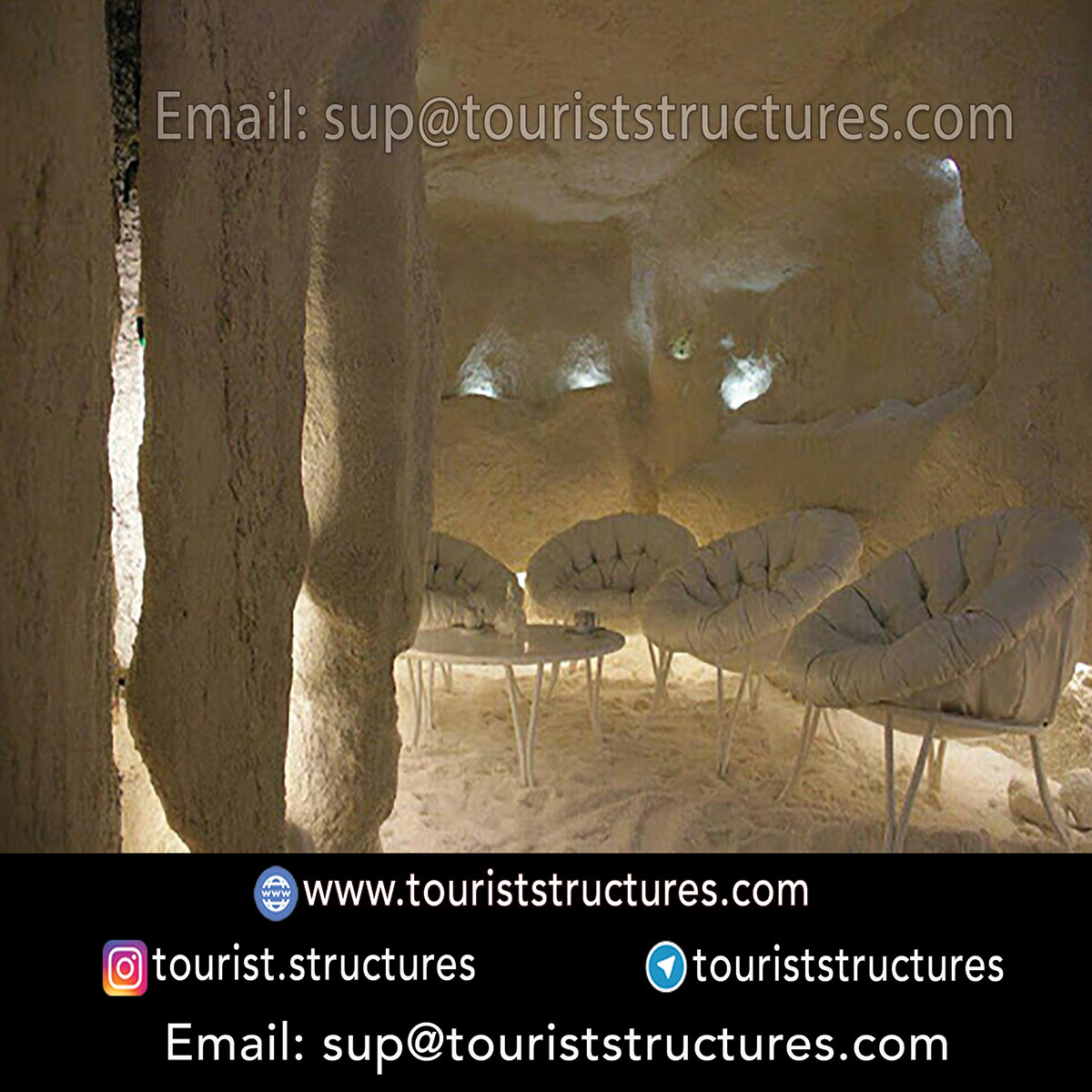

Various images of salt caves
Much like wooden, adobe, or earthen buildings, salt rooms or walls offer modern humans a chance to reconnect with nature in a way that concrete, cement, or stone structures cannot. In today’s industrialized world, whenever people return to nature’s embrace, it’s as if they rediscover themselves, experiencing an overwhelming sense of tranquility and rejuvenation.
Salt and rock salt, treasures drawn from the Earth’s depths, have captivated the modern world. However, today’s lifestyle rarely allows us the luxury of traveling long distances to salt mines or mountains to enjoy their benefits and positive energy. As a result, the idea emerged to bring salt caves into our living spaces. This is the origin of salt room and salt cave designs.
Thanks to modern technology, we can now create such environments at home, allowing us to relax and unwind whenever we wish. Even individuals unable to visit salt mines in person—like infants, the elderly, or patients—can now easily benefit from these spaces.


Salt spaces, serene environments for relaxation and catering to infants, the elderly, patients, and more.
Table salt, commonly used in food, is derived from these same rock salts, which have been processed into a fine powder, suitable only as a seasoning. However, the salt used in salt therapy must remain entirely natural, which makes constructing a salt room more complex. Imagine salt stones stacked together without the use of adhesives, cement, or any other binding agents to form the walls and ceiling of the room.
In essence, the structure consists entirely of natural salt. So far, research on the construction and effects of salt rooms has remained largely confidential, with no detailed guides available. After extensive investigation, the solution was found: water can be used as the bonding agent for salt stones.
A salt room is essentially a space where salt crystals and bricks cover the walls in a sterile environment, designed to facilitate energy healing with an emphasis on proper lighting. In these rooms, specialized generators and air-handling units are used to disperse fine salt particles throughout the space.


Images of salt therapy rooms
Another key element in salt room design is the necessity of proper ventilation and air purification systems to prevent furniture and flooring from being covered by floating salt particles.
As the healing properties of salt become more widely recognized, salt rooms are being incorporated into a variety of spaces, including homes, hotels, tourist resorts, sports facilities, yoga studios, massage parlors, wellness centers, luxury villas, branded towers, high-end commercial and residential complexes, offices, airports, kindergartens, and more. They are rapidly becoming popular among both clients and designers. The design of these rooms authentically replicates the feeling of being inside a natural salt cave.
It’s worth noting that salt rooms aren’t just for adults or therapeutic purposes. There are also dedicated salt rooms for children, equipped with toys and salt sand, which not only help treat various conditions but also provide entertainment and promote overall well-being.


Dedicated salt rooms for children
Salt room design: All you need to know about these marvelous structures!
If materials like granite and travertine feel overly familiar in your architectural and design projects, there’s an exciting alternative waiting for you—salt stone. It might come as a surprise that this stunning décor is made entirely from salt stone, adding an undeniable charm to the spaces it adorns.
It’s not uncommon for people to think of stones like marble, granite, and travertine as standard materials sourced from quarries, cut, and then incorporated into building façades. However, what often intrigues people is the idea of extracting salt stone from a mine and using it to create interiors and structures with unique and beneficial properties. Iran, with its rich and ancient salt mines, is home to high-quality salt stones in a variety of colors, which can be used to craft beautiful salt walls and rooms.
According to many designers, despite its intricacies and delicate details, designing a salt room is one of the most aesthetically rewarding and straightforward projects to undertake. With the right tools, a salt room can be created in virtually any space, even in very small areas.
These rooms often feature salt walls, specialized lighting, and floors made of salt stone or salt sands.
Pasargad Company takes pride in leveraging its vast knowledge, time-tested expertise, and a commitment to elevating Iran’s architectural landscape by delivering specialized and stunning structures. These designs stand as lasting reminders of Iran’s rich heritage in wellness architecture.

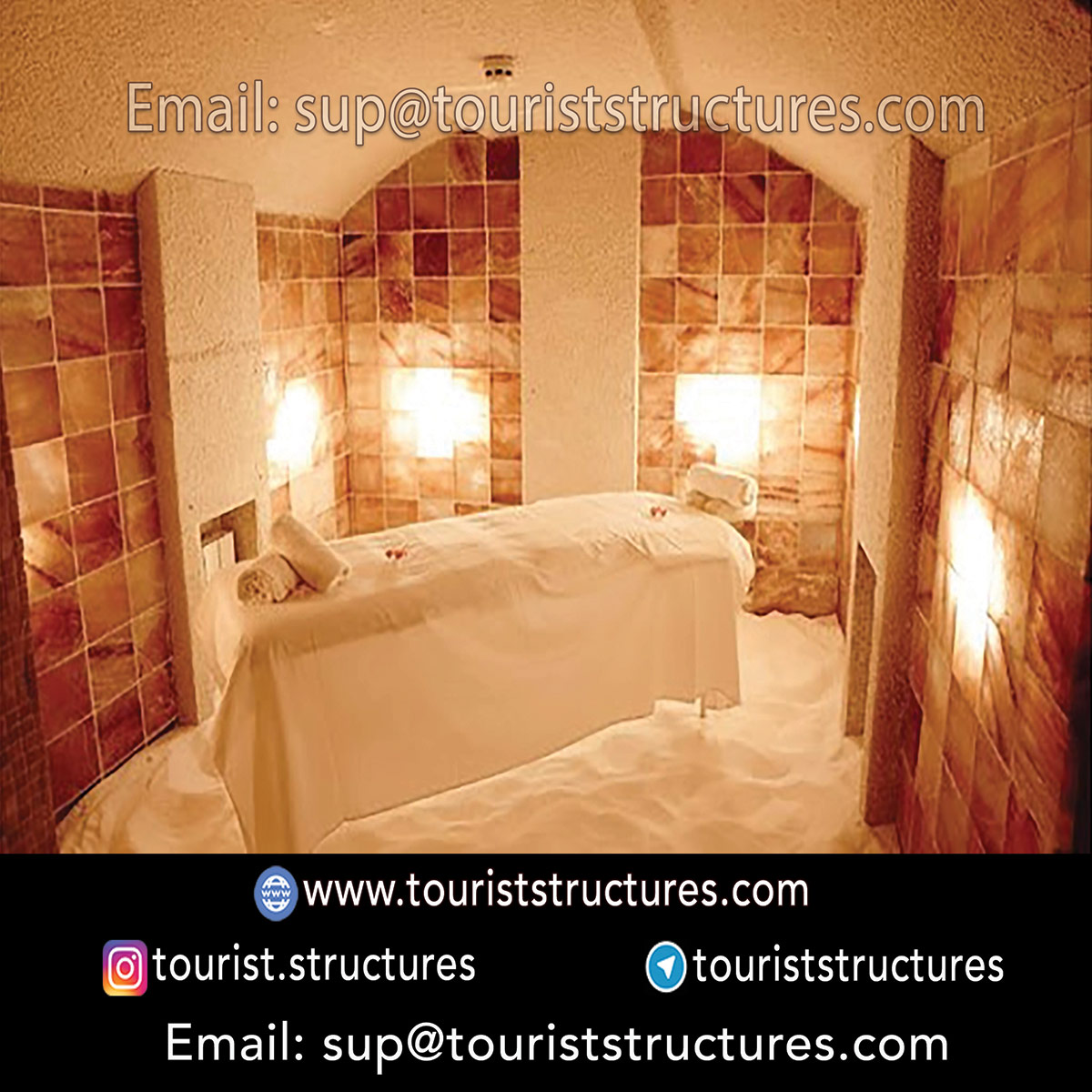

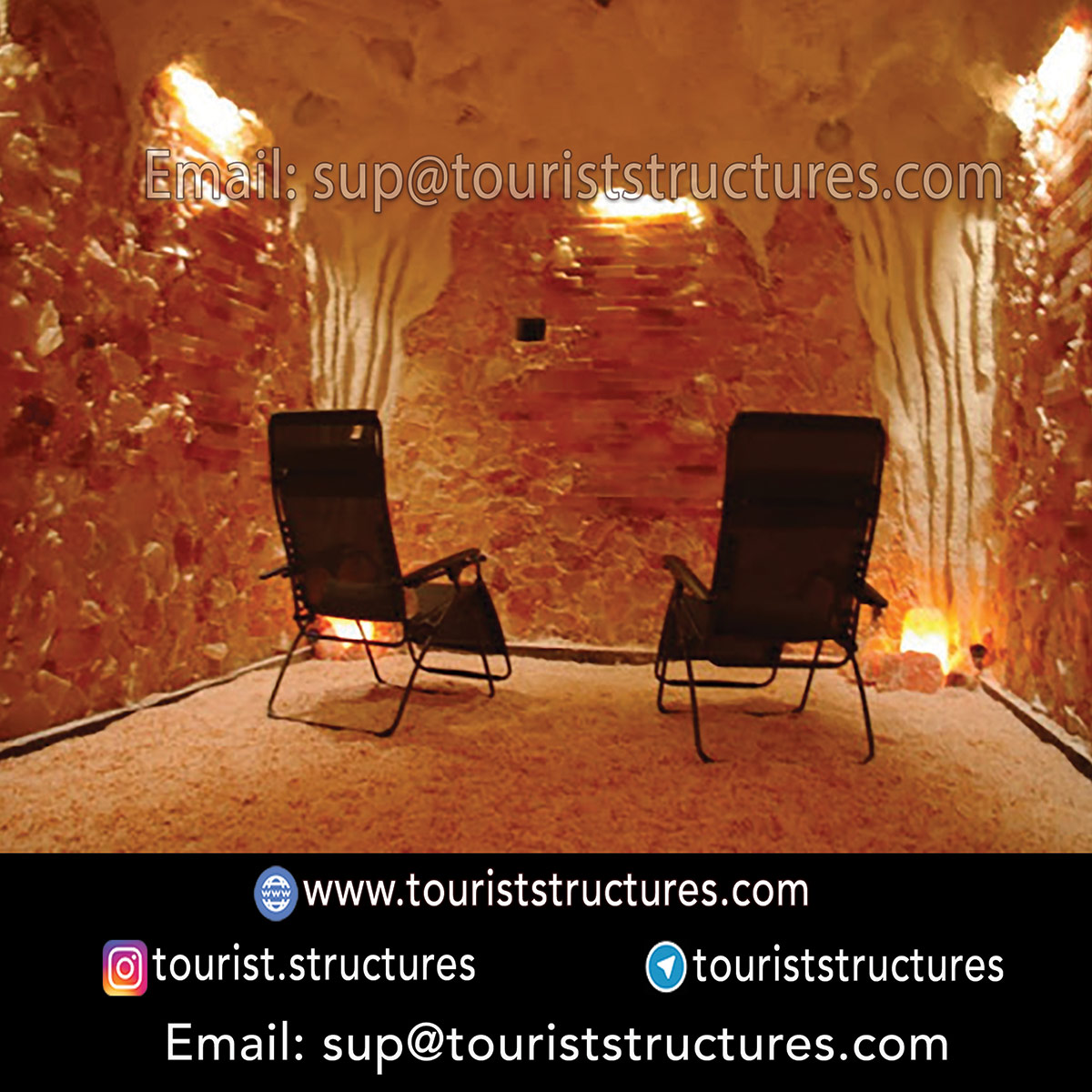
Exceptional salt room design services by Pasargad Company
Key Elements in Salt Room Design:
The design and construction of a salt room vary greatly depending on the client’s taste, budget, and the purpose of the space. Some clients seek modern, luxurious salt rooms, while others may prefer a more traditional design, focusing on the therapeutic benefits of salt therapy and maximizing the use of the available space.
The flooring in a salt room can range from being fully covered in salt to using other materials. The stone colors, lighting design, temperature control, equipment, and even the foundational preparations all depend on the client’s specific preferences and needs.
The arrangement of the salt room and its lighting is entirely customizable, allowing for a highly personalized and aesthetically pleasing space.



Customized salt room designs in various sizes, styles, and décor options
The cost of building a salt cave or room depends on the project size and the quality of materials used.
Building a salt room is a highly specialized task that requires expert consultation to avoid costly mistakes or unnecessary expenses.
Pasargad’s execution team offers free, specialized consultations before starting any project by conducting thorough site assessments to ensure the best results.
Innovative salt room ideas from Pasargad Company:
Lighting in salt room design:
Lighting is a crucial aspect of any building, especially salt rooms. It’s important to carefully plan where to position lights and whether to opt for warm or cool tones, with the help of professional designers.


Stunning lighting design in salt rooms
Adding Functional Spaces to Salt Rooms:
For those looking to build a commercially profitable salt room, it’s essential to incorporate spaces that cater to client needs. Examples include a café, relaxation beds, seating areas, children’s rooms, massage areas, and even salt baths.
Unique Architectural Designs:
One of the latest trends in salt room design for attracting clients involves creative architectural styles. Traditional rectangular designs are becoming less popular, even though they remain ideal for therapeutic purposes.
You might consider using powdered salt on the walls or incorporating ceilings that mimic a cave-like structure, with decorative salt stone accents.
Salt Powder Flooring:
For many, walking on uneven salt surfaces provides the ultimate foot massage, as the pressure is naturally aligned with the individual’s body weight.
Since numerous nerve endings are located in the feet, walking on rough surfaces softens and stimulates these nerves, resulting in a deep sense of relaxation. The warm and dry nature of salt also helps to draw out coldness and moisture from the feet, promoting blood circulation and creating a soothing experience for the entire body.
Salt, with its naturally warm and dry properties, can draw out cold and moisture from deep within the feet, helping to warm them and alleviate the stagnation of thickened blood in the soles. Walking on the uneven surfaces of crushed salt rocks has remarkable benefits—it softens and gradually eliminates the build-up of abnormal black bile in the blood. This process purifies the blood, boosts circulation, and increases oxygen delivery to tissues, particularly the brain. As a result, the calming and soothing sensation experienced by those in a salt room is greatly enhanced.
Building a Salt Tourism Village:
A salt village could include salt hotels, restaurants, chalets, cottages, markets, museums, and halotherapy (salt therapy) centers, all set within a beautifully landscaped environment. The addition of salt-themed attractions like salt-paved floors, salt-built furniture, and water-resistant salt sculptures would draw tourists seeking both leisure and wellness experiences. Other features, such as outdoor and indoor saltwater pools and Artemia breeding aquariums, would further enhance the appeal to both domestic and international visitors.
Salt Restaurants:
Restaurants are always designed with beauty and creativity in mind, ensuring they appeal to customers and create memorable dining experiences.
One of the latest restaurant design trends, recently seen in Shiraz, uses salt structures. To avoid monotony and create visual appeal, salt can be incorporated in various forms, such as powdered salt, salt stones, or compressed layers, for both modern and traditional designs.
In addition to their aesthetic appeal, these salt-based designs have practical benefits as well. The gases emitted by salt naturally disinfect the air, creating a clean and hygienic dining environment.


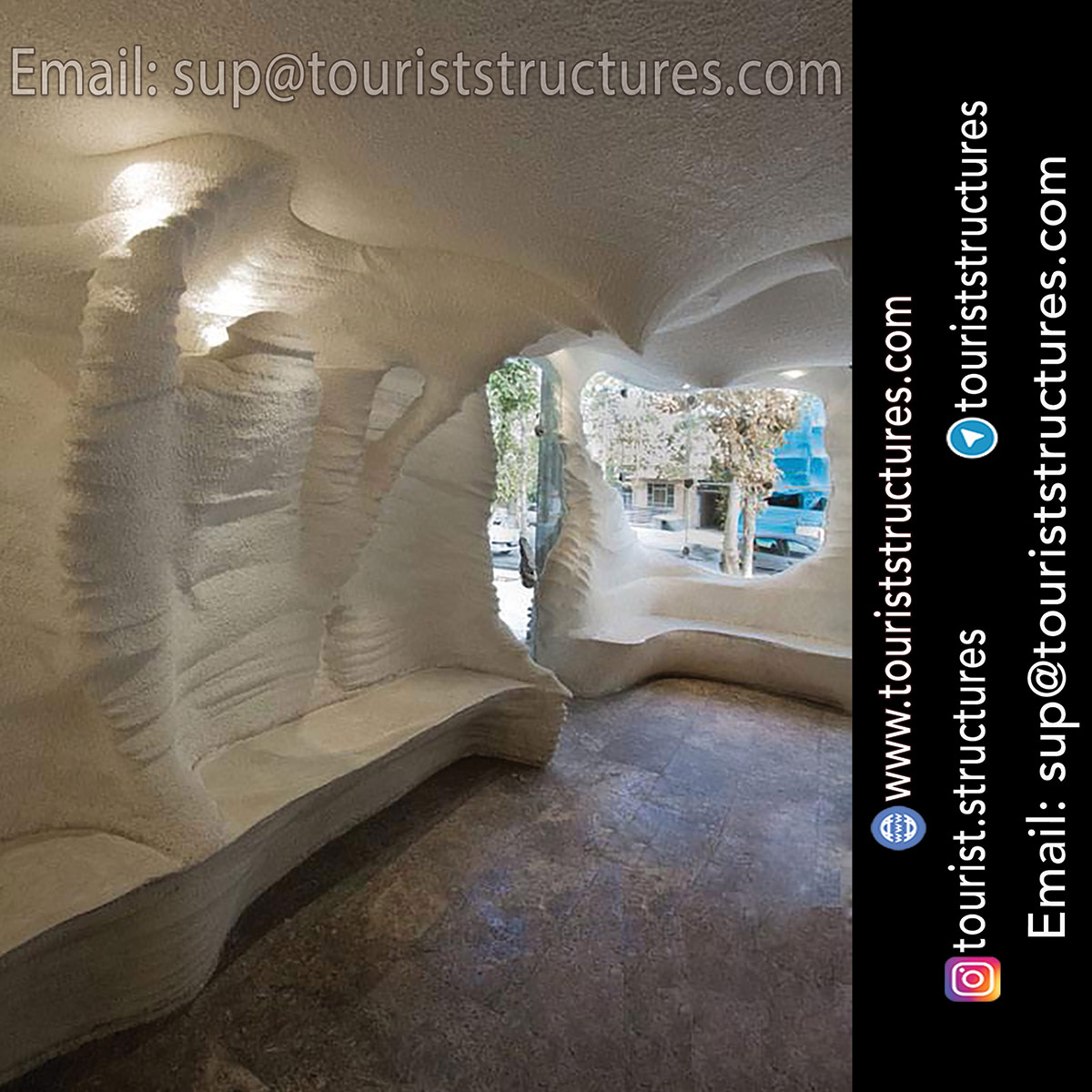

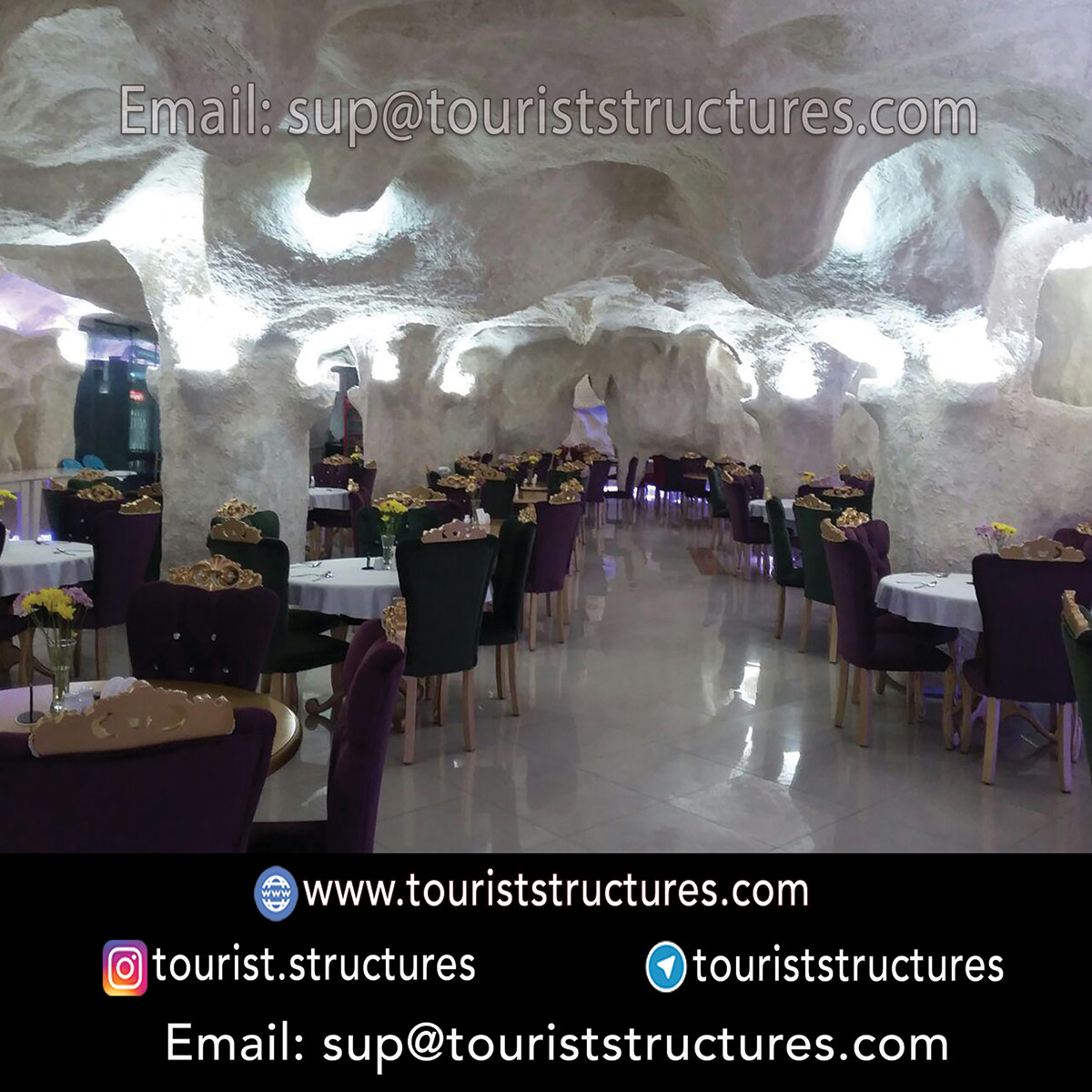
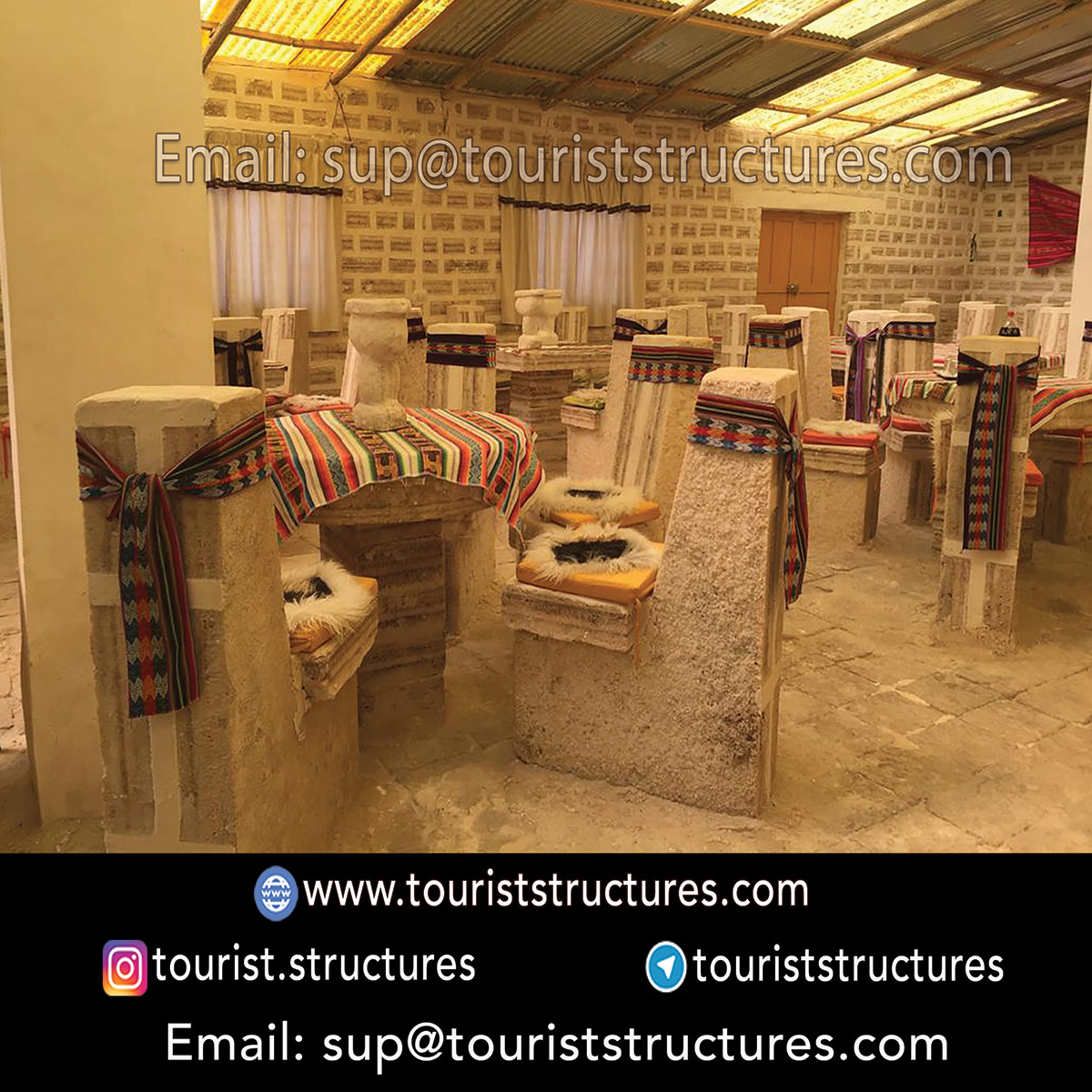
Salt restaurants in Shiraz and around the world.
It’s important to remember that designing and constructing this type of décor demands a high level of expertise, experience, and skill, given that salt stone behaves quite differently from other types of stone.
Aria Gostar Pasargad’s team of architects, designers, engineers, consultants, and skilled experts offers comprehensive services related to salt stone, ensuring the most professional and innovative salt-based structures are created. With years of experience in unique and diverse projects, Pasargad leads the way in specialized salt architecture.
Salt Therapy: A Growing Sector in Health Tourism
Salt therapy has a rich history spanning several centuries around the world. In countries with natural resources suited for it, salt therapy is taken very seriously, with significant investments made in this area. While salt therapy has received less attention in Iran compared to treatments like sand therapy, mud therapy, or hydrotherapy, doctors believe it can be highly effective in alleviating nervous pain, fatigue, migraines, neurological headaches, digestive disorders, and skin conditions. But can Iran’s natural salt caves meet the demand of health-conscious tourists?
Southern Iran is home to numerous salt domes and extensive salt mines. However, Garmsar is currently recognized as Iran’s center for salt therapy, although there is still much progress to be made before this city can cater to both local and international tourists.
Garmsar’s Salt Cave, located along the Garmsar-Tehran road, has attracted attention within the health tourism sector. Formed by floods that have eroded the surrounding salt rocks, the cave’s use for tourism, however, presents some safety risks.
While Iran boasts the world’s largest salt cave, the country is also rich in salt domes, salt mountains, and vast salt mines that, with proper research and investment, could be preserved and developed for tourism. By doing so, Iran could capture a significant share of the health tourism market.
And now, the bottom line…
One of the biggest global challenges today is pollution and the rise in respiratory diseases. Asthma has become a widespread condition, and respiratory and lung illnesses are growing at an alarming rate. Just imagine after a long, exhausting day, resting in a salt-infused environment where all your fatigue simply melts away—the thought alone is invigorating.
If salt rooms prove to have the exceptional healing effects claimed for respiratory conditions and allergies, they would truly be an extraordinary asset.
Moreover, Iran is rich in high-quality salt rock reserves. The structured, crystalline formation of salt rocks, combined with their quality and wide range of colors, makes them an ideal material for enhancing interior design aesthetics. Given this, and the proven therapeutic benefits of salt, it’s not hard to imagine that the number of salt therapy clinics, recreational and sports centers, yoga and massage rooms, saltwater pools, saunas, and more will rapidly increase across Iran.
Taking all of this into account, it’s clear that the development of therapeutic and recreational salt structures offers a highly lucrative opportunity—not just in Iran, but globally. As always, Pasargad Company’s expert consultants encourage you, esteemed investors, to seize this moment. By acting quickly, you can position yourself among the first and the finest in this burgeoning industry and secure impressive profits.
If you’ve never experienced a salt room before, make sure to try it at least once—you won’t regret it!
Pasargad Company stands at the forefront of the industry, specializing in the design, structural calculations, construction, and implementation of salt structures. Our approach hinges on engineering expertise and adherence to global standards.
Selecting any of the green options will navigate you to the corresponding sub-pages of the website.
